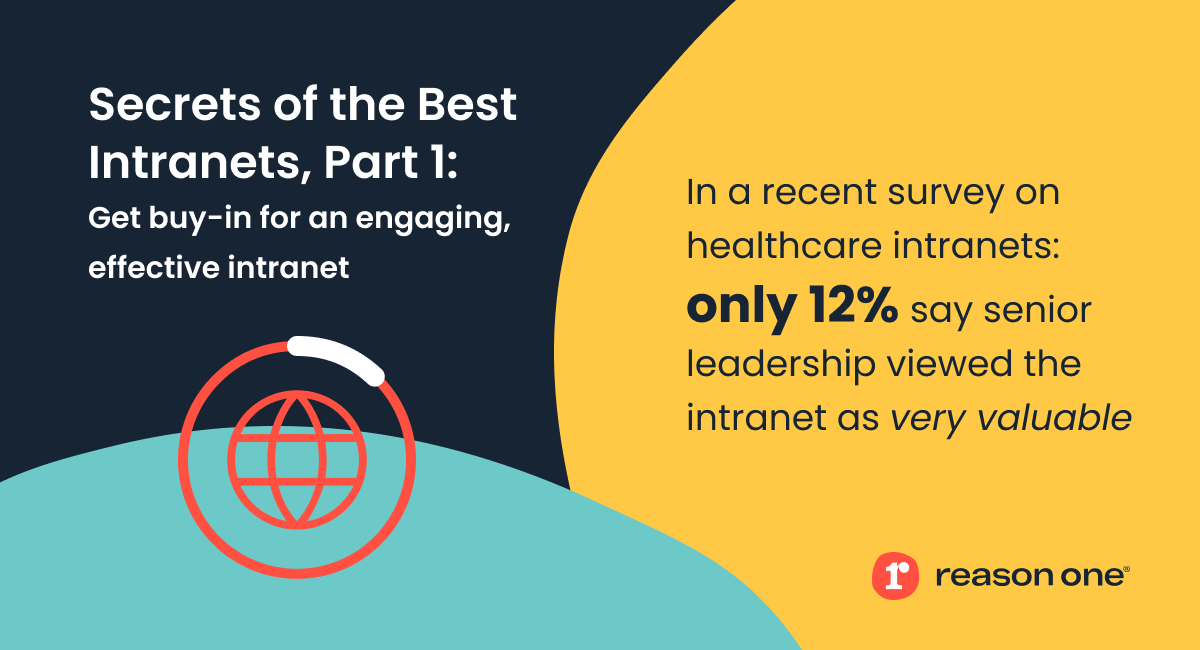Secrets of the Best Intranets, Part 1: Get buy-in for an engaging, effective intranet
Summary: Your intranet's success depends on leadership buy-in. Show them the analytics, budget ranges, and staffing benchmarks that will make them take notice.
Intranets are having a moment. The rapid shift to remote work coupled with the return to a hybrid setting are showing us that enterprise organizations are relying more and more on robust digital communications tools to keep teams connected and engaged. This is particularly true for healthcare intranets, where the ease of sharing quickly-changing health data has a direct effect on patient outcomes.
Unlike rapidly deployed collaboration tools like Zoom or Slack, intranets require more thought, more time, and more budget. But as you know, they’re essential and worth the work. This means they need executive champions for implementation and evolution.
Intranets need executive champions
In a recent survey we conducted with Greystone.net, only 12% of respondents indicated that their leadership viewed the intranet as "very valuable."

Wait, what? Our thoughts exactly. If that’s true, how do you get leadership to care? Your executives are thinking a lot about morale, turnover and retention, culture and inclusion, and operational efficiency. And those considerations have only become more focused and top of mind during the pandemic with remote work.
The most successful intranets:
Are led by MarComm
Have buy-in
Have budget
A plan
Used experience-based tech
But you don’t have to have all those things to be successful. What you do need is a strong, smart engagement strategy. Build your intranet around the needs of your organization.
Three steps to get executive buy-in
1. Gather performance data
Executives are busy and don’t often have visibility into the day-to-day tactical aspects of the healthcare system. Gather data from Google Analytics and your other tools to show them how the intranet is performing as a communications tool. Want even more support? Take an internal survey to share real employee feedback with leadership on what’s working and what’s not.
Help your leadership think of the intranet in terms of ROI. Connect the performance data to other areas of the business like retention, morale, and efficiency. Put the intranet in the context of a tool that brings multi-faceted value, because it does.
2. Share budget benchmarks
Intranets are unique in that they’re often a black box--it’s hard to compare yours with your competitors. This is especially true with your intranet budget. Providing your leadership with some benchmark budgets is one way to show how your intranet might stack up to others.
Our survey indicated that budgets ranged anywhere from less than $10,000 to $500,000 and (even beyond), which coincided with organization size. A simple takeaway for leadership is that the most effective enterprise intranets had annual budgets greater than $100,000.
3. Compare team size
Intranets need champions and stewards. Of the organizations we looked at, those with the most robust staffing had between 10 and 25 full-time employees. Over a third of organizations reported having two or fewer employees.
There were no top-performing intranets without dedicated resources. And those with two or more made up a majority of the top performers. This isn’t to say that you have to have a ton of dedicated resources, but it should give leadership a clear indication that success doesn’t happen without the right team.
Taking the next step
With these data points collected, you’re ready to make your case to leadership for improving your intranet. For more resources and to watch our full webinar on the Secrets of the Best Intranets, click here. Need more advice or have questions? Drop us a line.
